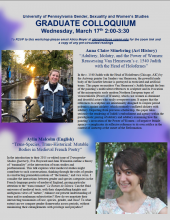Anna-Claire Stinebring (Art History)
“Adultery, Idolatry, and the Power of Women: Reassessing Van Hemessen’s c. 1540 Judith with the Head of Holofernes”
In the c. 1540 Judith with the Head of Holofernes (Chicago, AIC) by the Antwerp painter Jan Sanders van Hemessen, the powerful nude body of the Israelite heroine is portrayed in eroticized and artificial terms. This paper reconsiders Van Hemessen’s Judith through the lens of the painting’s multivalent references to sculpture and its evocation of the misogynistic early modern Northern European topos of vrouwenlisten (Power of Women), which cast women as dominant and deceitful actors who easily overpower men. It argues that the references to sculpture are intentionally designed to conjure period polemics against idolatry, which routinely conflated idolatry with adultery. Departing from previous scholarship, this paper takes seriously the rendering of Judith’s embodiment and agency within the paradigmatic pairing of idolatry and adultery examining how the painting’s invocation of the Power of Women—of negative female agency—complicates its reflexive reference to its own artifice in the context of Antwerp at the outset of the Reformation.
Aylin Malcolm (English)
“Trans-Species, Trans-Historical: Mutable Bodies in Medieval French Poetry"
In the introduction to their 2015 co-edited issue of Transgender Studies Quarterly, Eva Hayward and Jami Weinstein outline a theory of “tranimality” at the intersection of trans studies and posthumanism. This talk explores what medieval studies might contribute to such conversations, thinking through the roles of gender in constructing premodern notions of “the human,” and vice versa. I consider the interactions between gender and species categories in the French-language poetry of medieval England, paying particular attention to the “trans romance” Le Roman de Silence. Can the fluid universes of medieval texts, with their shapeshifting knights and ambiguous views of “nature,” enhance our present understanding of trans and/or nonhuman subjectivities? How do we negotiate their intersecting taxonomies of race, species, gender, and class? To what extent can we compare gender frameworks across periods, without minimizing their entanglements with privilege and prejudice?

 The Program in Gender, Sexuality, and Women’s Studies
The Program in Gender, Sexuality, and Women’s Studies